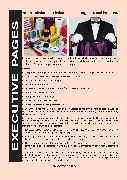EXECUTIVE PAGESFacing, Interfacing, Interlining and Lining, Trims and Fasteners Lining: Lining fabric refers to a group of materials inserted into various garments, from skirts and shorts to dresses, jackets and coats. Such fabrics can be made of natural or synthetic fibers and range from sheer to opaque. Purpose •The purpose of lining fabric is to make your garment more wearable, long-lasting and comfortable. •They are usually lightweight and have a soft or silky texture. •To make the garment less see-through •To add warmth and durability •To make the inside part of the garment soft and pleasant to the touch •To lend a luxury note to a garment •To improve the structure of a garment •To help the garment slide on easily •To conceal seams, padding, interfacing, etc. If the garment is not stretchy, e.g. a cotton shirt or a wool jacket, non-stretch lining fabric is ok. But if the item is made with elastic materials like jersey, tulle or stretch satin, the lining one ends up choosing should be stretchy as well. Interfacing: Interfacing is a support fabric used in areas that need more stability than just the fabric weight. For example, you’ll find interfacing in collars, cuffs, waistbands, closures (like buttonholes), and sometimes hems. In tailored garments, you may find interfacing under entire garment sections, and more than one type used within a single garment. •Lining is attached to the inner part of the garment to help keep its shape, hide the interior construction and facilitate the whole putting on/taking off thing. •Interlining is added to a garment for extra warmth and insulation (some examples include fleece or flannel) and can be removable, in which case it is also called ‘a liner’. •Underlining provides more body and opacity: it is cut for every pattern piece separately and attached to the wrong side of the outer fabric. Mind that the double layer material you get in this case is treated as one. Types: Silk, viscose, acetate, polyester and rayon are among the most popular fibers used for lining materials. In many ways, the fiber type is the key factor: it influences the way your lining feels to the touch, the way it sews and drapes, its breathability and – last but not the least – the price point. Below are the types of lining cloths available on the market: NCM-OCTOBER 2021 17
